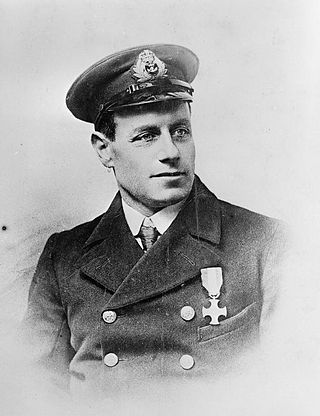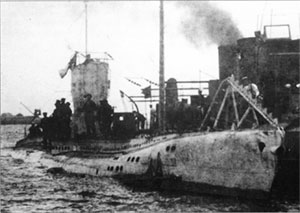
Thomas Crisp VC, DSC, RNR was an English sailor and posthumous recipient of the Victoria Cross. Crisp, in civilian life a commercial fisherman operating from Lowestoft in Suffolk, earned his award after being killed during the defence of his vessel, the armed naval smack Nelson, in the North Sea against an attack from a German submarine in 1917.
SM UC-41 was a German Type UC II minelaying submarine or U-boat in the German Imperial Navy during World War I. The U-boat was ordered on 20 November 1915 and was launched on 13 September 1916. She was commissioned into the German Imperial Navy on 11 October 1916 as SM UC-41.

SM U-86 was a Type U 81 submarine manufactured in the Germaniawerft, Kiel shipyard for the German Empire during World War I.
SM U-28 or U-XXVIII was a U-27-class U-boat or submarine for the Austro-Hungarian Navy. U-28, built by the Austrian firm of Cantiere Navale Triestino (CNT) at the Pola Navy Yard, was launched in January 1917 and commissioned in June.
SM UB-47 was a Type UB II submarine or U-boat for the German Imperial Navy during World War I. UB-47 was sold to the Austro-Hungarian Navy during the war. In Austro-Hungarian service the B was dropped from her name and she was known as SM U-47 or U-XLVII as a member of the Austro-Hungarian U-43 class.

SM UB-43 was a Type UB II submarine or U-boat for the German Imperial Navy during World War I. UB-43 was sold to the Austro-Hungarian Navy during the war. In Austro-Hungarian service the B was dropped from her name and she was known as SM U-43 or U-XLIII as the lead boat of the Austro-Hungarian U-43 class.

SM UB-10 was a German Type UB I submarine or U-boat in the German Imperial Navy during World War I.
SM UB-12 was a German Type UB I submarine or U-boat in the German Imperial Navy during World War I. The submarine disappeared in August 1918.

SM UB-16 was a German Type UB I submarine or U-boat in the German Imperial Navy during World War I. The submarine was sunk by a British submarine in May 1918.
SM UB-17 was a German Type UB I submarine or U-boat in the German Imperial Navy during World War I. The submarine disappeared during a patrol in March 1918.

SM UB-2 was a German Type UB I submarine or U-boat in the German Imperial Navy during World War I. She sank eleven ships during her career and was broken up in Germany in 1920.

SM UB-6 was a German Type UB I submarine or U-boat in the German Imperial Navy during World War I. The submarine was interned after running aground in neutral Dutch waters, and was scuttled by her crew at Hellevoetsluis.
SM UC-11 was a German Type UC I minelayer submarine or U-boat in the German Imperial Navy during World War I. The U-boat was ordered on 23 November 1914, laid down on 26 January 1915, and was launched on 11 April 1915. She was commissioned into the German Imperial Navy on 23 April 1915 as SM UC-11. Mines laid by UC-11 in her 83 patrols were credited with sinking 27 ships. UC-11 was mined and sunk on 26 June 1918. A crew member was Rudolf Finkler from Oberlinxweiler, Kreis St. Wendel, Germany. According to his death record the boat went down in the North Sea near Harwich, abt. 2.5 nautical miles north east of Funk Feuerschiff on position 51°55′N1°41′E.
SM UC-14 was a German Type UC I minelayer submarine or U-boat in the German Imperial Navy during World War I. The U-boat was ordered on 23 November 1914, laid down on 28 January 1915, and was launched on 13 May 1915. She was commissioned into the German Imperial Navy on 5 June 1915 as SM UC-14. Mines laid by UC-14 in her 38 patrols were credited with sinking 16 ships, one of which was the Italian pre-dreadnought battleship Regina Margherita, which at 13,427 tonnes displacement was one of the largest ships sunk by U-boats during the war. UC-14 was mined and sunk on 3 October 1917.
SM UC-55 was a German Type UC II minelaying submarine or U-boat in the German Imperial Navy during World War I. The U-boat was ordered on 12 January 1916, laid down on 25 February 1916, and was launched on 2 August 1916. She was commissioned into the German Imperial Navy on 15 November 1916 as SM UC-55.
SM UC-63 was a German Type UC II minelaying submarine or U-boat in the German Imperial Navy during World War I. The U-boat was ordered on 12 January 1916, laid down on 3 April 1916, and was launched on 6 January 1917. She was commissioned into the German Imperial Navy on 30 January 1917 as SM UC-63. In nine patrols UC-63 was credited with sinking 36 ships, either by torpedo or by mines laid. UC-63 was torpedoed and sunk by HMS E52 off Goodwin Sands on 1 November 1917; only one crewman survived the sinking.
SM UC-71 was a German Type UC II minelaying submarine or U-boat in the German Imperial Navy during World War I. The U-boat was ordered on 12 January 1916 and was launched on 12 August 1916. She was commissioned into the German Imperial Navy on 28 November 1916 as SM UC-71. In 19 patrols UC-71 was credited with sinking 63 ships, either by torpedo or by mines laid. UC-71 sank on 20 February 1919 in the North Sea while on her way to be surrendered. Discovery a century later of her wreck with all hatches open suggested she had been deliberately scuttled by her own crew.
His Majesty's or HM Armed Smack Inverlyon was a fishing smack that was converted to a Q-ship during the First World War. Q-ships served as decoys to lure German submarines near enough so that concealed weapons could be brought to bear and sink the submarines. On 15 August 1915, Inverlyon succeeded in luring German submarine UB-4 within range and sinking her with nine shots from her gun. The Royal Navy Gunner in command of the vessel, Ernest Martin Jehan, received the Distinguished Service Cross and members of Inverlyon's crew shared the bounty offered for German submarines. After Inverlyon's Q-ship career ended, she returned to fishing, but was sunk by U-55 on 1 February 1917.
Armed trawler Nelson was a British auxiliary warship which served during World War I. She was built in 1905 as the fishing smack G&E, operating from Lowestoft and registered as LT 649. In 1915 she was armed for defence against U-boat attack, and fought several actions against them. She was sunk in action on 15 August 1917. This action was fought between a German U-boat and two trawlers, Nelson and Ethel & Millie, off the English coast.
The Armed trawler Ethel & Millie was a British auxiliary warship which served during World War I. She was built in 1908 as the fishing smack Ethel & Millie, operating from Lowestoft and registered as LT 200. In early 1917 she was armed for defence against U-boat attack, and fought two actions against them. She was sunk in action on 15 August 1917.








